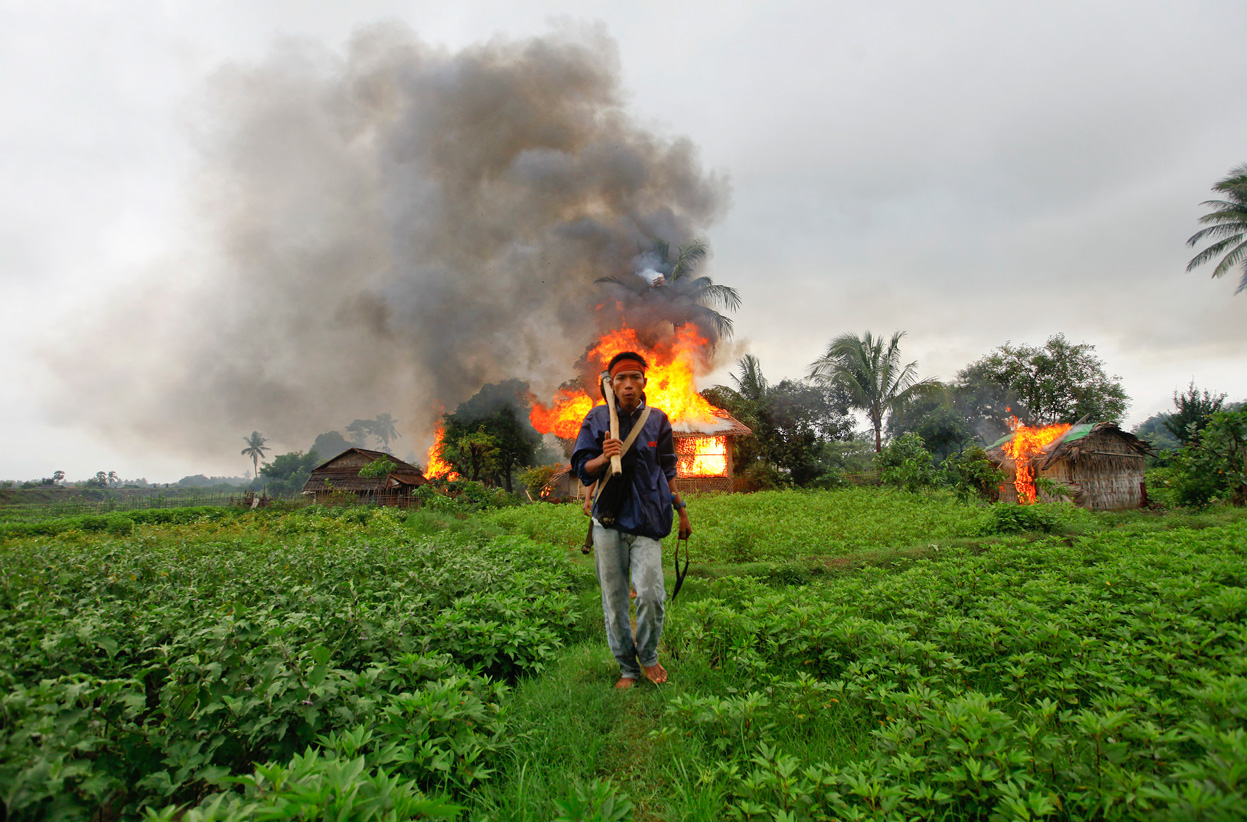The Sentinel Project has released a report assessing the risk of genocide against Muslim minorities in Burma and has found the risk level to be high in light of intensified persecution.

A resident of Rakhine State walks past burning homes during anti-Rohingya violence in Sittwe during summer 2012. The year since has seen similar incidents, increased hate speech, and the ghettoization of the Rohingya. Source
The initial enthusiasm surrounding recent political reform in Burma has recently given way to reminders of the dark legacy of the nation’s past. Among the most notable of these expositions was a July 2013 cover story published by Time Magazine in which journalist Hannah Beech showed that the specter of past crimes against humanity, including genocide, have resurfaced in Burma and that extremist forces in the country have focused their attention upon the Muslim minority within the Buddhist-majority state.
In May 2013, in response to the mounting threat against the Muslim Rohingya population in Burma, the Sentinel Project launched an intensive research initiative into the current situation in Rakhine State and Burma as a whole. The purpose of this work was to explore the threat against the Rohingya and provide advanced warning in the event that genocide was found to be imminent. The result of this work – combining analysis of structural factors in the newly-released risk assessment with open-source monitoring tools such as Threatwiki and confidential sources inside Burma – has shown the Rohingya to be at a high risk of genocide, whether by violent extermination or by the slow destruction of the group through isolation and starvation.
While much media attention has emphasized the role of the allegedly “grassroots” 969 movement, which aims to boycott Muslim businesses and customers, the Sentinel Project has found the reformist government, local governments, and Burmese security forces to also be either complicit or actively involved in ethnic cleansing campaigns. The violence which has unfolded during numerous incidents has reportedly taken place in full view of government security forces, which have done little, if anything, to intervene and stop it. In fact, there often appears to be some degree of cooperation between security forces and civilian perpetrators of violence. Violent mobs that have carried out ethnic cleansing in places such as Sittwe and Meikhtila were well-organized, with the Rohingya escorted out of these areas with their hands raised in the air, and the presence of agents provocateurs observed as well as bulldozers which razed Muslim houses in the wake of their departure.
Burma currently presents a textbook case for a country on the brink of genocide, with numerous indicators of virtually all of Gregory Stanton’s Ten Stages of Genocide (besides extermination itself), which the Sentinel Project has adapted into its monitoring framework. The machinery of genocide – the complex systematic processes designed to eliminate the Rohingya – is already operating in Burma and has carried ethnic cleansing and isolation to its current point; mounting evidence supports allegations that genocide in Burma is currently ongoing, and may merely be a matter of scale.
There are many key indicators of genocidal intent, such as the Burmese government’s attempts to limit reproduction amongst the Rohingya ethnic group; proposed restrictions on intermarriage between Muslims and Buddhists; continued employment of hate speech against this minority (both Rohingya specifically and Muslims in general); and forced registration of Rohingya under a “foreign” ethnic identity, thus attempting to provide documentary denial of the existence of the group. All of these factors, outlined in detail in the risk assessment, indicate intent to exterminate the Rohingya.
The Sentinel Project’s risk assessment concludes that, apart from outright violent extermination (i.e. mass killing) of the Muslim Rohingya minority, two conditions would need to be observed in order to declare the campaign against the Rohingya genocide: (1) continued ethnic cleansing and ghettoization of the Rohingya and other Muslims, and (2) continued isolation and deprivation of internally displaced persons (IDP) camps.
Rather than reducing the risk of mass killing, states in transition, whether from democracy or authoritarianism or authoritarianism to democracy, have been found to be more at risk of mass killing than those which are firmly at one end of the spectrum or the other. Thus, while Burma’s apparent democratization may present the commonly-believed image of a nation backing away from military rule, brutal treatment of minorities, and the brink of genocide, its current transitional state may actually place it in a precarious position that augments the risk of genocide. Recent reforms may prove to be simply cosmetic with the regime and officially-backed 969 movement continuing on the path to systematic extermination. The Rohingya are currently in need of preparations for self-defense, a workable evacuation plan, and possible international intervention (whether diplomatic or military). The Sentinel Project’s ongoing monitoring work will be particularly focused on determining whether Burma changes course or continues on its current path.
Click here to read the full report (PDF).
We also launched a new visualization of escalating anti-Rohingya persecution in Burma on a Map, read our announcement on our blog
